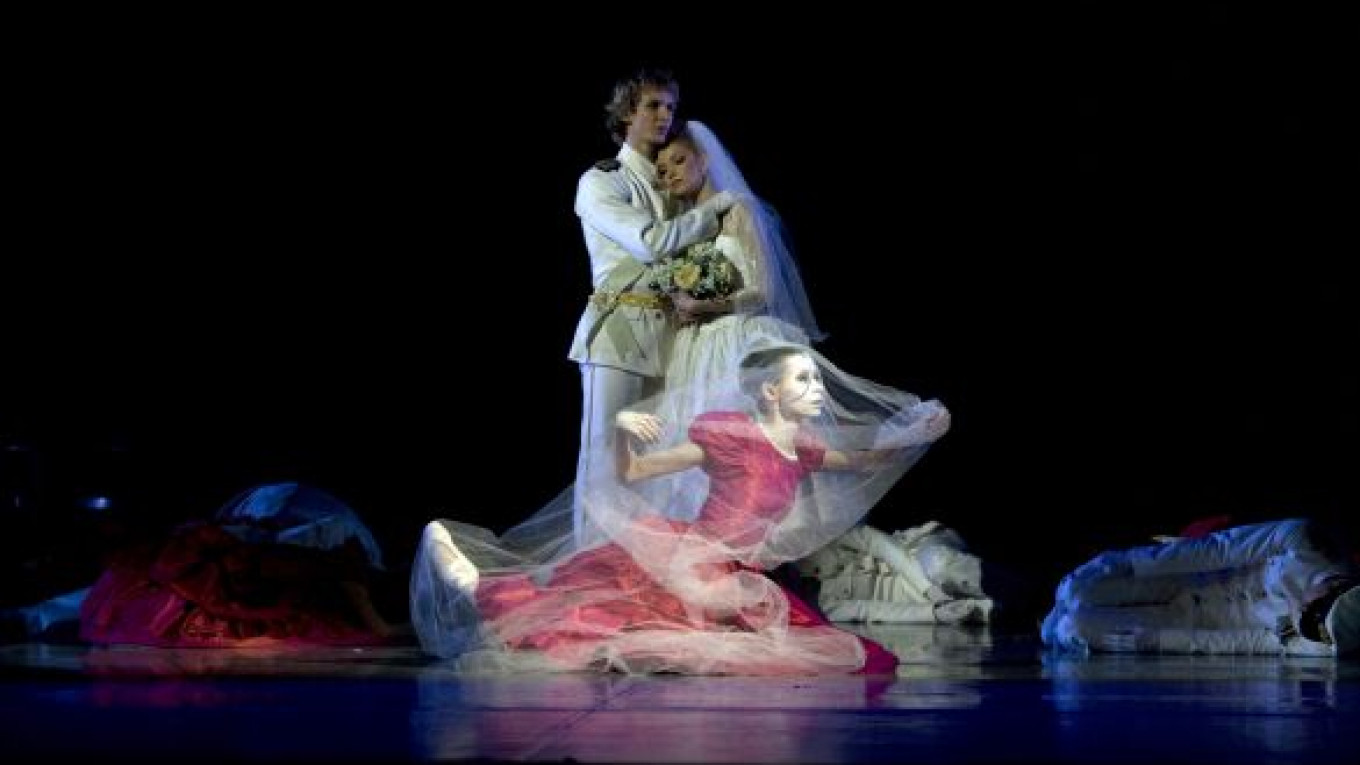This season, the Stanislavsky and Nemirovich-Danchenko Musical Theater has added to its already impressive repertoire of contemporary ballet three more superior works by present-day masters of the choreographic art.
Leading off the parade last November was Finnish-born, Boston-based Jorma Elo’s one-act “Slice to Sharp,” an invigorating piece of abstract dance created in 2006 for the New York City Ballet. Next, in February, came “The Little Mermaid,” a stunningly beautiful adaptation by Hamburg-based American John Neumeier of Hans Christian Andersen’s familiar fairy tale that first came to the stage six years ago in Copenhagen in celebration of the 200th anniversary of Andersen’s birth. And last week saw the premiere of “Por Vos Muero,” a brilliant half-hour-long tribute to the Spanish Renaissance by Nacho Duato, originally choreographed in 1996 for the Compania Nacional de Danza in Madrid, which Duato headed for nearly two decades.
Duato is already a familiar figure to Moscow audiences from his hugely successful production at the Stanislavsky and Nemirovich-Danchenko of “Na Floresta” and his memorable visit here with his Madrid company at last year’s Chekhov Festival, and is likely to become much more familiar to Russia in general in his new post as ballet artistic director of St. Petersburg’s Mikhailovsky Theater.
“Por Vos Muero” seamlessly interweaves elements of Spain’s Golden Age with those of the present day. From the former come allusions to various dance forms of the Renaissance, a suggestion of courtly dress — the men in doublets (but without hose), the women in long dark dresses — a simple scenic background of huge red curtains descending from above and a black, velvet-covered wall pierced with doorways that evokes in atmosphere the paintings of Spain’s Renaissance masters, recorded music of the era played and sung in authentic style under the direction of its most renowned present-day exponent, Jordi Savall, and excerpts from the sonnets of early 16th-century poet Garcilaso de la Vega read by Spanish actor Miguel Bose.
In its choreography, however, the ballet is unquestionably of modern vintage, with Duato drawing on his seemingly inexhaustible supply of lifts, carries and movement in general that test the human body to its very limits and appear to spring directly from the accompanying music. The 12 dancers seen in the first of two casts brought to it all of the energy, enthusiasm and skill that have become a hallmark of the Stanislavsky and Nemirovich-Danchenko during recent seasons in its approach to contemporary ballet.
The theater combines “Por Vos Muero” with “Slice to Sharp” and “Na Floresta.” Together they form what is probably the most exhilarating evening of dance now to be found on any Moscow stage.
I missed “The Little Mermaid” at its February premiere and only caught up with it at a performance early last month. Despite glowing reports, I was totally unprepared for its overwhelming beauty and for the consummate skill with which Neumeier has managed to transfer Andersen’s story to the ballet stage.
“The Little Mermaid” comes remarkably close to what composer Richard Wagner called a “Gesamptkunstwerk” — a total work of art — for not only did Neumeier create the dance, he also designed the sets, costumes and lighting and must surely have given a guiding hand to Russian-born American composer Lera Auerbach as she constructed the ballet’s score.
Judging by Neumeier’s earlier work for the Stanislavsky and Nemirovich-Danchenko, his dance version of Anton Chekhov’s play “The Seagull,” his “A Midsummer Night’s Dream” at the Bolshoi Theater in 2004 and the other works of his I’ve seen on DVD and television, I believe he stands nearly alone today as a choreographer capable of producing a convincing full-length story ballet.
At the performance of “The Little Mermaid” that I saw in May, the large cast seemed to meet Neumeier’s demands with almost total authority, and Anastasia Pershenkova gave an extraordinarily touching and superbly executed performance of the title role as she moved from her undersea realm to testing her new human legs on land and eventually sinking into despair as her beloved prince rejected her for another woman.
Neumeier’s “The Little Mermaid” is definitely not Walt Disney, but a work of psychological profundity that seems meant principally for adults — though it is likely to be much enjoyed as well by children with at least several years of school behind them.
No fan of ballet should risk missing either “Por Vos Muero” or “The Little Mermaid.” Both are indisputably masterpieces of dance.
The final performances this season of the triple bill including “Por Vos Muero” (Za vas priyemlyu smert) play on Monday, Tuesday and July 26 and of “The Little Mermaid” (Rusalochka) on June 21 and July 15, all at 7 p.m., at the Stanislavsky and Nemirovich-Danchenko Musical Theater, located at 17 Bolshaya Dmitrovka. Metro Chekhovskaya, Pushkinskaya. Tel. (495) 629-2835.
A Message from The Moscow Times:
Dear readers,
We are facing unprecedented challenges. Russia's Prosecutor General's Office has designated The Moscow Times as an "undesirable" organization, criminalizing our work and putting our staff at risk of prosecution. This follows our earlier unjust labeling as a "foreign agent."
These actions are direct attempts to silence independent journalism in Russia. The authorities claim our work "discredits the decisions of the Russian leadership." We see things differently: we strive to provide accurate, unbiased reporting on Russia.
We, the journalists of The Moscow Times, refuse to be silenced. But to continue our work, we need your help.
Your support, no matter how small, makes a world of difference. If you can, please support us monthly starting from just $2. It's quick to set up, and every contribution makes a significant impact.
By supporting The Moscow Times, you're defending open, independent journalism in the face of repression. Thank you for standing with us.
Remind me later.






